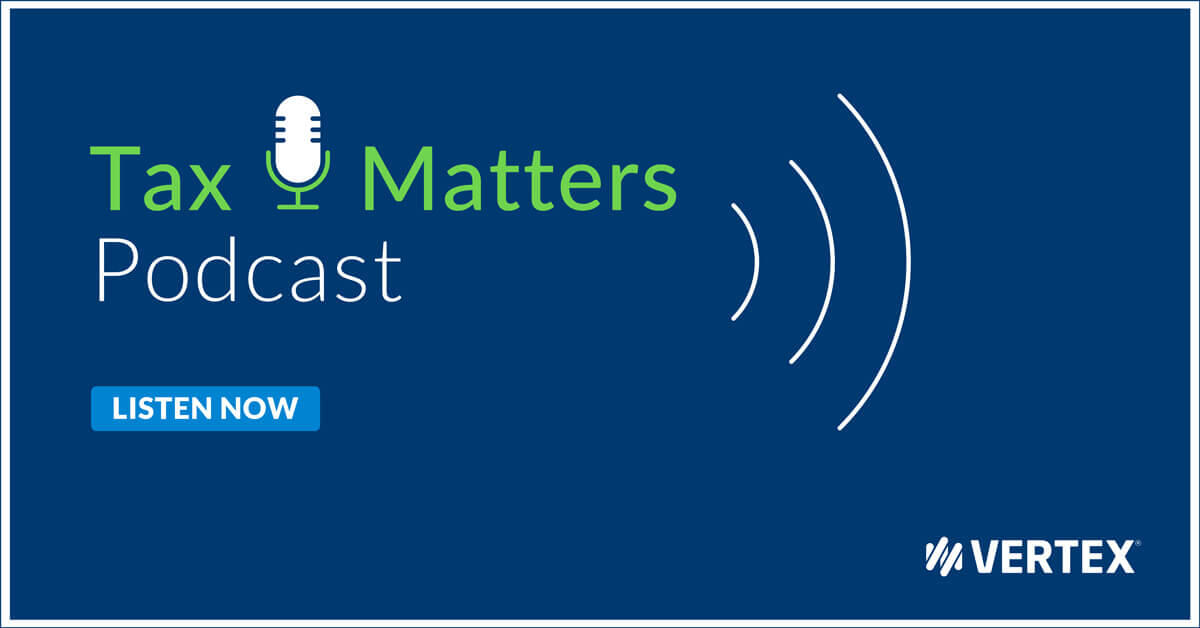Tricia Schafer-Petrecz: Welcome to Tax Matters, a Vertex podcast! I’m Tricia Schafer-Petrecz, External Communications Lead at Vertex.
In this episode, we feature new insights on subscription sales models from Forrester Senior Analyst Joe Cicman.
Joe helps eBusiness groups assess, improve, and optimize eCommerce technologies and strategies. He conducts extensive research on the tools and software suites that support online channels, digitally-enabled selling, and direct-to-consumer (DTC) initiatives.
In this conversation with business writer Eric Krell, Joe discusses the benefits of subscription sales models. Joe also talks about challenges that need to be addressed for companies to optimize subscription sales. Sales tax compliance features prominently among these issues.
Now I’ll turn it over to Joe and Eric…
Eric Krell: Welcome, Joe. It’s good to have you on. Let’s start by talking about the subscription landscape. Why is this a growing business model?
Joe Cicman: I think I’ll set the stage here with some research that my colleague, Jay McBain, and I did about a year ago called The Future of Distribution. What we looked at, Eric, was when COVID hit, we saw that for IT distributors that demand destruction and substitution triggered their systemic risk. I’ll go through some of those and talk about how subscription was the phantom menace in a lot of this. So, one, this rapid and reactionary shift to digital. What happened when the lockdown started is that businesses that hadn’t already been digital said, “I need to get to digital fast.” They had to go to SaaS, because you can’t get quickly to digital by buying a bunch of routers and plugging them in and doing the whole on-prem thing. There wasn’t time on the clock, and the only option there was SaaS. Number two, you had the changing nature of the B2B tech buyer. We call this the “B2B consumer.” This is a B2B buyer whose digital preferences are influenced by their experiences as consumers. They walk into a buying situation very, very differently. They have consumer grade expectations that they are levying on their vendors.
Eric Krell: And, Joe, those expectations, I’m guessing, are more intense -- more demanding, correct?
Joe Cicman: Yeah, they’re more intense, more demanding. What we find in terms of digital preferences is that a lot of the interaction modes -- the preferences -- they line up with generations. The way I would summarize this is that these preferences are set during the formative years of someone’s life. That’s what really pops out at me when I look at the data. But this isn’t only about Millennials. Boomer CFOs are buying their new cars from digital [platforms] without ever visiting a dealership. So, it’s pervasive.
Eric Krell: So, we had … the pandemic that accelerated digital transformation, we have the embrace of subscription-as-a-service and, as you mentioned, we have these changing expectations. I’m guessing that’s all feeding into the growth of the subscription model, correct?
Joe Cicman: Yes, the subscription model is the force behind this decline. When you look at a business that operates on a subscription, it’s a more resilient business model. They have more direct customer relationships. They have more scalable assortment-expansion strategies. And there is more precedent – if you look, there are a number of large tech companies that are going all-subscription. So, there is a tremendous force behind subscription. It just makes a better business model. In fact, you’re going to get higher valuations. Let’s say you and I are business owners, we’re going to get higher valuations from the street from investors when we have a subscription model. That’s evident -- just look at the multiples.
Eric Krell: Like you said, from a consumer's perspective I think about subscription models from my personal experience: music, which is wonderful; video; some apps like weigh-management, fitness-tracking, stuff like that. Can you give me a range of subscription models? Because I'm guessing that the types of businesses that use them are far broader than what I experience as a consumer…
Joe Cicman: I’ll use one that we’ve all touched, and I’ll talk about some of the other innovative direct models that they have. So, Zoom is a subscription, but they’re able to do some interesting stuff with that subscription. They apply a product-led growth strategy…. Somebody in a business will sign up. And first off, Zoom 45 minutes for free, and then they cut you off. Well, you’ve got to have longer calls, so you enter a credit card. That’s great. You’re inside a big organization, you can handle that expense. Zoom knows when they’re getting credit cards, hundreds of credit cards from people inside that business. And when they do that, they pick up the phone to the CFO and they say something to the effect of, “You know you’ve got 300 people paying us every month on their credit cards? I can offer you a different option.” That’s the sales cycle – a product-led growth strategy sales cycle. Compare that to like perpetual license conferencing software. It’s night and day how you do the go to market. You see this in oil and gas, people who sell earth moving equipment to mining companies, fleet management – all of those are digital services. The whole John Deere and Caterpillar, all of the stuff that they do. These are subscription digital services that manage physical assets.
Eric Krell: You're already hitting on some of the key differences, but at a high level, tell me what's important to keep in mind if I ask you how sales tax is different in a subscription model vs. a more traditional or one-time buy and sell approach...
Joe Cicman: I’m going to give you an example of a marketplace model. When I look at marketplaces, I say that there’s marketplaces selling either bits or they’re selling add-ons. So, they’re selling software or they’re selling physical goods. And so, to illustrate this, I’m going to use an example of resellers of add-ons. The punch line is, when you are re-selling through a marketplace model, your revenue is commission, it’s not resell margin. And there are a couple of other implications there. If we’re doing first-party reselling, so if you and I have a traditional distribution business, we buy stuff on pallets, stick it in our warehouses, it’s ours. We can do whatever we want with it. We sell it. So, under that situation, first-party reselling companies do take physical possession of goods by sticking them into inventory. They do also take title of those goods. And they do have full control over those. Now, if we want to expand our assortment, but we don’t have $6 billion of additional working capital, we might consider a couple of alternatives, one of those alternatives would be non-stocked items or dropship. Now, in those situations, we don’t take physical possession of goods into our inventory. However, for a moment, in a flash, we do take title to those goods. But because we take the order, we do a back-to-back order, and we say, “Hey, supply or ship it right to the customer,” we don’t really have control over those goods. The third model then is if we become a marketplace. Amazon Business does this: they talk about 50% of their business, their GMV [gross merchandise value] coming from resell.... In that case, companies like ours would not take physical possession of the goods into inventory, we would not take title of the goods, and we don’t have control over them, we just facilitate.... We let somebody else make their own listing. That revenue to me as a marketplace operator is commission, it’s not resell revenue.
Eric Krell: So, when I think about the sales tax implications, my first thought is, this is incredibly complex. When I hear you speak, I hear about all the different factors that have potentially different compliance outcomes and requirements attached to them. Can you talk a little bit about some of the sales tax challenges and risks that are involved in subscription models?
Joe Cicman: As a technology analyst, I’m not a tax advisor … However, what I can tell you is it’s tremendously important to lay out your business model the way I described. Lay that out to your tax professional. This is not something that the businesses digital leaders want to do on their own. This is not something that you want to let your CIO figure out. This is a conversation you need to have very intentionally with your company’s tax expert. Now, as I’ve worked with companies that have made this migration, some of the lessons that I can say bubble up are: Talk to that tax expert early and talk to them often. Expect that they’re not going to have a 15-minute conversation about this and be totally motivated the next day to rework everything in the organization. So, be patient. It’s work for them, and it takes intentional planning. It’s not a switch to be flipped.
Eric Krell: Joe, you have a background in e-commerce. And what you're talking about is sitting down the folks involved with e-commerce and almost mapping it out. Have you seen that as an effective practice? That sounds interesting to me – mapping out how the different transactions work so that the tax people can see what the potential implications are…
Joe Cicman: When you go into subscription business models, and if you talk to anybody in software who lived through the days of being on-premise and then doing SaaS, it breaks everything. It breaks all of your accounting, everything has to be re-imagined because you’re going from -- let’s say we’re in software -- we’re going from selling a $3 million deal, very choppy revenue throughout the quarter. And when we go to a subscription base, you’ll say, “I don’t want to say amortize it, but that’s one way to visualize it.” You’re taking the total revenue over, I don’t know, five years, seven years, whatever it is -- stretching it out. And so, you’re getting little bits at a time. You’ve got to think differently about paying your salespeople because they’re going to get lower commission checks. … You’re going to be paying your people differently. And that’s in SaaS. Now, when we go to physical marketplace-selling, again your revenues turn into commissions. You don’t use first-party buyers, you use recruiters. Now, nobody’s going to subscribe to work boots. But I use those physical examples to lay some of the groundwork… As someone selling those bits, you have a choice of either selling your own bits, your own software, or selling your own software alongside or packaging it alongside other people’s software. And so, if you are selling subscriptions, you are probably going to be in the business of selling your own stuff as subscriptions and selling other people’s stuff as subscriptions.
Eric Krell: Joe, this is excellent. When I listen to you, I can understand why the subscription model is growing so rapidly. You talked about the benefits to forecasting, the benefits to valuations, to resiliency. Before we go today -- you talked a little bit about what folks involved with e-commerce can do to help make the tax groups life easier. Any suggestions for tax groups and working with their counterparts on this?
Joe Cicman: Yeah, show everybody the love. This is a massive influx of complexity. It will feel like a pain in the neck, it is the inevitable drumbeat of progress. I would say, relative to other transformations your organization has undergone, this might be the biggest one, depending on how old your company is. I talked to a company a few months ago, they actually sold whale oil back in the day. And now they’re into different types of lighting. So, companies have historically gone through these transitions. It might be the biggest one in the career of the people you work with. So, I’d say approach that with a great deal of empathy. And one of the things we see in digital transformation in general is everyone on that team needs to understand the why, because it’s going to be a lot of work. This can’t be a pet project, everybody’s got to understand the why. They’ve got to understand how they all contribute to the solution, and it’s not evident on day one how they will. So, you’ll want to workshop that. You want to give it the attention that it deserves as a long-term transformation as opposed to some little quick hit thing that we’re going to do to get a little bit of a revenue bump. So, treat it as the transformation that it really is.
Eric Krell: Well, thanks so much, Joe. That was incredibly illuminating, and I really appreciate it.
Tricia Schafer-Petrecz: Thank you for listening to Tax Matters, a Vertex podcast…Check back here for more episodes soon.
Note: This transcript has been edited for clarity.


